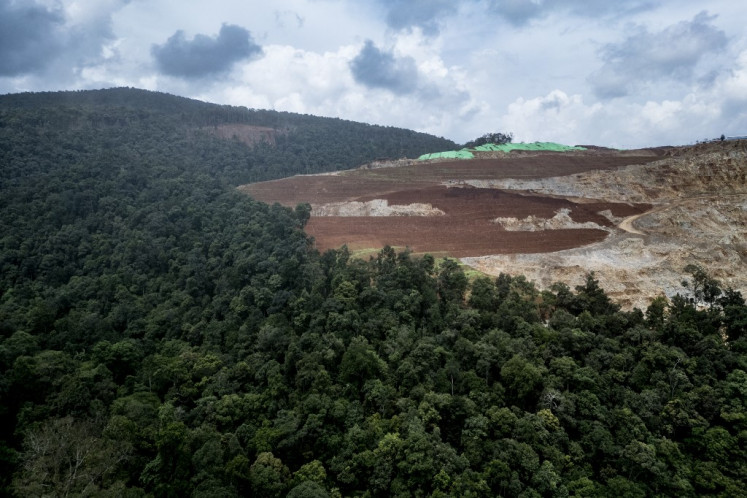Popular Reads
Top Results
Can't find what you're looking for?
View all search resultsPopular Reads
Top Results
Can't find what you're looking for?
View all search resultsDeaths on crowded Mount Everest: Why is there a jam on the world's highest peak?
The world's highest peak has attracted large crowds in recent days, but this has also contributed to the growing number of fatalities in Nepal's Himalayan mountains.
Change text size
Gift Premium Articles
to Anyone
 In this file handout photo taken on May 22, 2019 and released by climber Nirmal Purja's Project Possible expedition shows heavy traffic of mountain climbers lining up to stand at the summit of Mount Everest. Three more climbers have died on Everest, expedition organisers and officials said on May 24, taking the toll from a deadly week on the overcrowded world's highest peak to seven.
(Handout/Project Possible/AFP/File)
In this file handout photo taken on May 22, 2019 and released by climber Nirmal Purja's Project Possible expedition shows heavy traffic of mountain climbers lining up to stand at the summit of Mount Everest. Three more climbers have died on Everest, expedition organisers and officials said on May 24, taking the toll from a deadly week on the overcrowded world's highest peak to seven.
(Handout/Project Possible/AFP/File)
At least 10 people have died climbing Mount Everest this week.
The world's highest peak has attracted large crowds in recent days, but this has also contributed to the growing number of fatalities in Nepal's Himalayan mountains.
At least 20 people have died climbing in the Himalayas this season.
A photograph taken by mountaineer Nirmal Purja from Mount Everest shows a long line of climbers queueing to ascend a steep ridge to the summit, and the crowd in his picture provided a glimpse into the tough conditions at the summit of the mountain.
Several climbers died while waiting to descend the mountain this week.
Why is there a jam?
A few days of clear weather this week has attracted large numbers of climbers looking to summit the 29,029-ft mountain.
An estimated 600 people had reached the summit via the Nepal side by Friday, a government official said, based on information from expedition organizers.
According to AFP, Nepal has issued a record 381 permits - which cost about US$11,000 (S$15,100) each - to hopeful climbers this year.
Hikers are accompanied by local or international guides on their journey, meaning that more than 750 climbers are expected to tread the same path.
In addition, at least 140 others have been granted permits to scale Everest from the northern flank in Tibet.
This means that the total number of climbers reaching the peak this season could surpass last year's record of 807.
Read also: Everest braces for record year amid overcrowding fears
According to experienced guides, queues at the summit of Everest are not uncommon.
This is due to the unpredictable and sometimes narrow window of suitable climbing weather, which may result in many climbers attempting to reach the summit at the same time.
Director of programs at Alpine Ascents International Gordan Janow, who has been organising treks to Everest for around 30 years, told AFP that the overcrowding seems to be worsening every year.
Why is the congestion at the summit dangerous?
Traffic jams on the mountain are hazardous for climbers, who are often already exhausted and carrying heavy loads while battling altitude sickness.
An Indian climber who died on Everest this week, Anjali Kulkarni, died while descending from the top of the mountain.
According to the 55-year-old's expedition organiser Arun Treks, her descent had been delayed by heavy traffic, which led to her death.
German climber Ralf Dujmovits, who reached the Everest summit in 1992, wrote in an Instagram post that the large number of people trying to ascend the mountain within the short weather windows can be hazardous.
Long waits in the bottlenecks of the climbing routes can be deadly for climbers as they may run out of oxygen, he added.
In his post, he advised climbers to avoid "massively crowded days" and to "be patient" in waiting for a good weather window.
What are the other dangers on Everest?
Apart from the pitfalls of altitude sickness and exhaustion, there are other natural dangers on the world's highest peak.
There have been a number of avalanches on the mountain over the years, some which have been fatal.
In 2015, a 7.8-magnitude earthquake struck Nepal, causing landfall which swept down the mountain and through the base camp. At least 18 people died and dozens more were injured.
This article appeared on The Straits Times newspaper website, which is a member of Asia News Network and a media partner of The Jakarta Post






